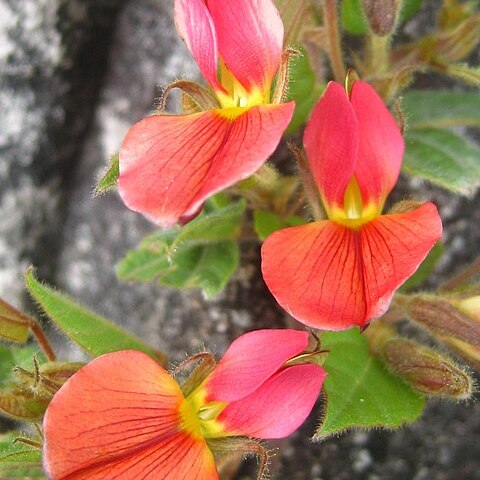Usually vines, creeping or twining, rarely erect shrubs or subshrubs. Leaves pinnately 3-foliolate; stipules usually caducous; stipels persistent or absent; leaflets usually with sessile glands abaxially. Inflorescence axillary, racemose, sometimes branched or 1-flowered. Bracts usually deciduous, rarely persistent. Calyx campanulate, 5-lobed, upper 2 lobes ± connate, lowest 1 longer. Corolla longer than calyx or short; standard circular or obovate, base with inflexed auricles, with or without appendage; wings and keels subequal, inflexed. Stamens diadelphous; vexillary stamen free; anthers uniform. Ovary sessile or subsessile; ovules (1 or)2; style curved above middle, usually hairy at lower part; stigma terminal. Legume oblong, oblanceolate, obovoid-ellipsoid, obliquely orbicular, sickleform, or ellipsoid, dehiscent, compressed or inflated, (1 or)2-seeded, not septate, apex always beaked. Seeds (1 or)2, usually suborbicular or reniform; hilum round, funicle in middle, strophiole small or absent.
and beneath; stipules caducous, striate, free; stipels reduced when present; pet-ioles 1.2-8.0 cm long, villous; petiolules 0.4-3.0 cm long, terminal petiolules longer than the laterals. Inflorescence racemose, axillary; bracts caducous or persistent, small, striate. Flowers with the calyx campanulate, the upper teeth at least partly connate; corolla papilionaceous, usually yellow with maroon mark-ings, the standard obovate, auriculate with a short claw, the wings oblong, not auriculate, the claw narrow, the keel falcate, wider than the wings, the claw attenuate; stamens diadelphous, the vexillary stamen free, the anthers mono-morphic; the style slender, the stigma entire, capitate, the ovary sessile, biovu-late. Fruits ovate to oblong, 2-valved, pubescent, gland-dotted; seeds 2 ovate, black often with some red, hilum lateral, ovoid to elongate.
Cal-tube short, obconic, nearly regular, the lobes about equal, lanceolate, much exceeding the tube, the 2 upper connate part-way; pet about equal in length; standard broadly obovate, narrowed to the base; wings oblong, blunt; keel-pet oblong, somewhat incurved; stamens 10, diadelphous; ovary and fr pubescent; style glabrous; fr flat, dehiscent, 1–2-seeded; trailing, twining, or erect perennial herbs with 1-foliolate or pinnately 3-foliolate lvs and lacking stipellules; fls small, yellow, in axillary racemes, without bracteoles. (Dolicholus) 200, warm reg.
Seeds reddish-brown, black or sometimes bright blue, compressed-globose or subreniform; hilum rounded to elongate, lateral, short, or at least never extending for more than a quarter of the periphery; rim aril obsolete to well developed, but mostly absent in African species, (except in a few cases, as in section Nomismia for example).
Leaves 1-foliolate or pinnately, rarely subdigitately, 3-foliolate (bipinnate in one South African species); leaflets usually with very conspicuous resinous gland dots beneath; stipules present; stipels very small.
Ovary (1)2-ovuled, often velvety; style mostly long, tenuous and mostly hairy on the lower part, incurved, glabrous, somewhat flattened and usually stiffened above; stigma small, terminal.
Corolla small or medium sized, frequently yellow lined with brownish-purple; standard with small auricles, but without or with only traces of appendages or calli, glabrous or hairy.
Herbs or subshrubs, twining or trailing, erect to ascending; stems terete to angular and striate.-Leaves trifoliolate, ovate to rhomboid, gland dotted above
Inflorescences axillary or terminal, racemose or paniculate, the flowers rarely solitary; bracts present, often well developed; bracteoles absent.
Pods almost circular to narrowly oblong, often falcate, compressed, frequently glandular and velvety.
Climbing prostrate or sometimes erect herbs or subshrubs, rarely pyrophytic.
Calyx 5-lobed; lobes unequal, the upper pair ± joined.
Vexillary stamen free; anthers uniform.

